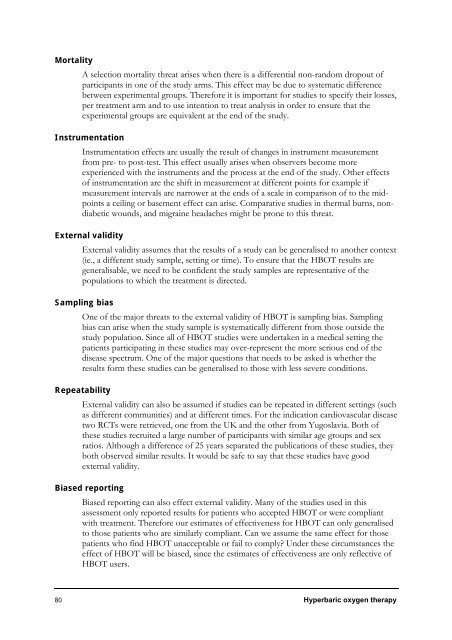Hyperbaric Oxygen Therapy - Hyperbaric Chamber Information ...
Hyperbaric Oxygen Therapy - Hyperbaric Chamber Information ...
Hyperbaric Oxygen Therapy - Hyperbaric Chamber Information ...
You also want an ePaper? Increase the reach of your titles
YUMPU automatically turns print PDFs into web optimized ePapers that Google loves.
Mortality<br />
A selection mortality threat arises when there is a differential non-random dropout of<br />
participants in one of the study arms. This effect may be due to systematic difference<br />
between experimental groups. Therefore it is important for studies to specify their losses,<br />
per treatment arm and to use intention to treat analysis in order to ensure that the<br />
experimental groups are equivalent at the end of the study.<br />
Instrumentation<br />
Instrumentation effects are usually the result of changes in instrument measurement<br />
from pre- to post-test. This effect usually arises when observers become more<br />
experienced with the instruments and the process at the end of the study. Other effects<br />
of instrumentation are the shift in measurement at different points for example if<br />
measurement intervals are narrower at the ends of a scale in comparison of to the midpoints<br />
a ceiling or basement effect can arise. Comparative studies in thermal burns, nondiabetic<br />
wounds, and migraine headaches might be prone to this threat.<br />
External validity<br />
External validity assumes that the results of a study can be generalised to another context<br />
(ie., a different study sample, setting or time). To ensure that the HBOT results are<br />
generalisable, we need to be confident the study samples are representative of the<br />
populations to which the treatment is directed.<br />
Sampling bias<br />
One of the major threats to the external validity of HBOT is sampling bias. Sampling<br />
bias can arise when the study sample is systematically different from those outside the<br />
study population. Since all of HBOT studies were undertaken in a medical setting the<br />
patients participating in these studies may over-represent the more serious end of the<br />
disease spectrum. One of the major questions that needs to be asked is whether the<br />
results form these studies can be generalised to those with less severe conditions.<br />
Repeatability<br />
External validity can also be assumed if studies can be repeated in different settings (such<br />
as different communities) and at different times. For the indication cardiovascular disease<br />
two RCTs were retrieved, one from the UK and the other from Yugoslavia. Both of<br />
these studies recruited a large number of participants with similar age groups and sex<br />
ratios. Although a difference of 25 years separated the publications of these studies, they<br />
both observed similar results. It would be safe to say that these studies have good<br />
external validity.<br />
Biased reporting<br />
Biased reporting can also effect external validity. Many of the studies used in this<br />
assessment only reported results for patients who accepted HBOT or were compliant<br />
with treatment. Therefore our estimates of effectiveness for HBOT can only generalised<br />
to those patients who are similarly compliant. Can we assume the same effect for those<br />
patients who find HBOT unacceptable or fail to comply? Under these circumstances the<br />
effect of HBOT will be biased, since the estimates of effectiveness are only reflective of<br />
HBOT users.<br />
80 <strong>Hyperbaric</strong> oxygen therapy



